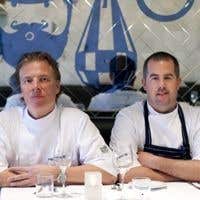This article was also published in the Financial Times.
On a recent trip to Amsterdam I followed the principles of economy many restaurateurs and chefs now practise when conducting their own R&D around the world: to spend as little as possible on travel and accommodation in order to leave as much as possible for the all-important food and wine.
An Amsterdammer pointed me towards the 17th-century Hotel Brouwer overlooking the Singel canal, where a comfortable room and a substantial breakfast cost 84 euros. I was urged to take second helpings of the slices of mature Gouda by the Argentine manager, but there is no wifi and they do not accept credit cards.
The hotel is, however, only a short walk from the Central station, at which the train from the airport stops, and in the course of that walk I managed to spend my first four euros on a broodje haring.
On a windy bridge over a canal is a stall belonging to Stubbe Haring manned by three jolly women seemingly impervious to the cold. The broodje, a soft roll stuffed with herring, onions and diced cucumber, was promptly assembled and almost as swiftly enjoyed. As an aperitif, this combination of doughy bread around such sharp, acidic ingredients proved as appetising, if even less widely available, as a glass of fino sherry.
A herring stall is a simple structure from which to practise financially viable hospitality, but a 60-seater restaurant that specialises in serving top-quality fresh fish, as Visaandeschelde opposite the RAI Congress Hall in the south of the city has done for the past 11 years, is a more complex proposition. As soon as I walked in and waited to be seated I noticed several distinctive practices, however.
Firstly, my coat and name were taken not by a receptionist but by a waiter. He subsequently took me to my table and then handed me the menu and wine list. He next returned to our table to clear our empty main-course plates.
As I sat and watched a highly enthusiastic team of young men and women run this dining room, each dressed in egalitarian white shirts and black trousers, but without the presence of a more authoritative manager, I realised that I was watching the restaurant equivalent of the 'total football' practised by Ajax, the great Amsterdam football team of the early 1970s. Nobody has specific roles; everyone supports one another; and, as a result, the customer really benefits. The person in charge proved to be, I discovered only by asking, a dynamic 31-year-old waiter.
While my appetite was whetted by a bowl of thin anchovy biscuits on the table and my ears grew attuned to the bell being sounded by the chefs in the open kitchen calling the waiting staff to come and collect the food, my hands felt the white butcher's paper that covered the linen tablecloth. This particular ingredient in the restaurant seemed to me to epitomise the determination of its proprietor Michiel Deenik (pictured above left with his chef, courtesy of Jaap Scheeren) to combine top-quality cooking with a relaxed atmosphere and an eye to economy.
This type of waxed paper is widely used in mid-priced restaurants, particularly across the US, but here in more expensive surroundings it certainly did not look out of place. Rather it conveyed the impression that the considerable saving on the laundry bill would find its way into the ingredients on the plate. And so it proved.
My first course, described as mackerel with lobster and wasabi, was a riot of colour and distinctive flavours, particularly the contrast of the oily, inexpensive mackerel with the more luxurious shellfish. Better still was a fillet of perch with an unlikely but winning combination of small tubes of beetroot and square of black pudding. Dessert, yoghurt with diced blood oranges and a pistachio cream, was again visually attractive and highly satisfying.
With a bottle of Dönnhoff 2008 Nahe Riesling at 40 euros that worked most successfully as our aperitif and with everything we ate, my bill for a three-course dinner for two came to 181 euros. I left with the memory of a highly distinctive restaurant.
Visaandeschelde is the equivalent of any top fish restaurant in Paris but the service in the French capital would be more formal, the wine list more proscribed. In London or New York a similar restaurant would, more than likely, have been bought and sold during this period, its identity diluted or its size extended to satisfy new investors. Here it remains true to itself and, most importantly, to its customers.
Another reason it does so, according to Ronald de Groot, editor of the Dutch Perswijn magazine, is that Deenik does not follow the practice of many in Holland of multiplying the cost price of their wines four- or five-fold, a practice de Groot leads a constant battle against.
Another practitioner of gentler wine pricing, and a very good value menu, is the team behind Café Dauphine opposite Amstel station.
The name derives from of an old model of Renault car, an example of which sits proudly outside the entrance surrounded by bicycles, while its menu describes Dauphine as a café/restaurant although in fact it is neither. Instead, it is an excellent brasserie.
Although it looks to France for its flexible, friendly menu, Dauphine does not draw on any of the imitation decor that seems to be widely used by less confident practitioners. Instead, the large, high-ceilinged room is a mass of light wooden tables set simply with generous white linen napkins, all occupied by a sea of customers eating or drinking or, when doing neither, communicating via cyberspace.
A single sheet of paper that doubles as the menu and wine list is the gateway to such pleasures as oysters; trays of shellfish; crab and lobster; and, most inexpensively and memorably, shrimp croquettes with toast and fried parsley.
Hotel Brouwer, www.hotelbrouwer.nl
Visaandeschelde, www.visaandeschelde.nl
Dauphine, www.caferestaurantdauphine.nl

